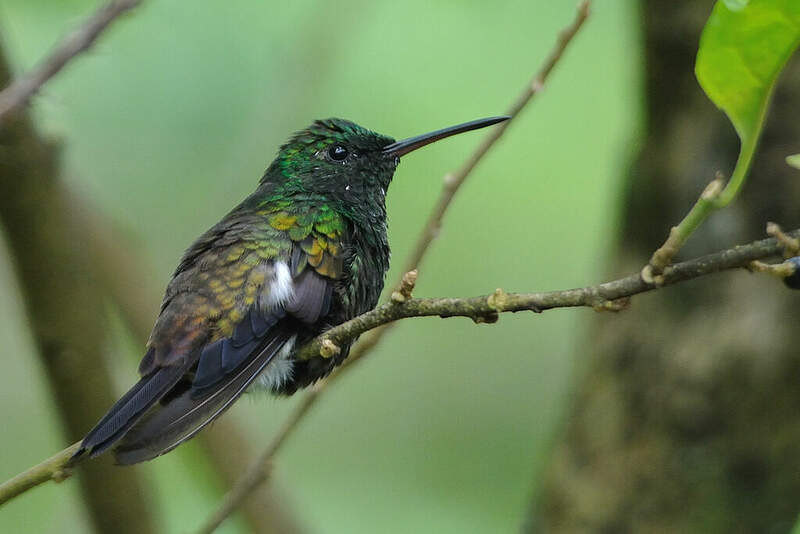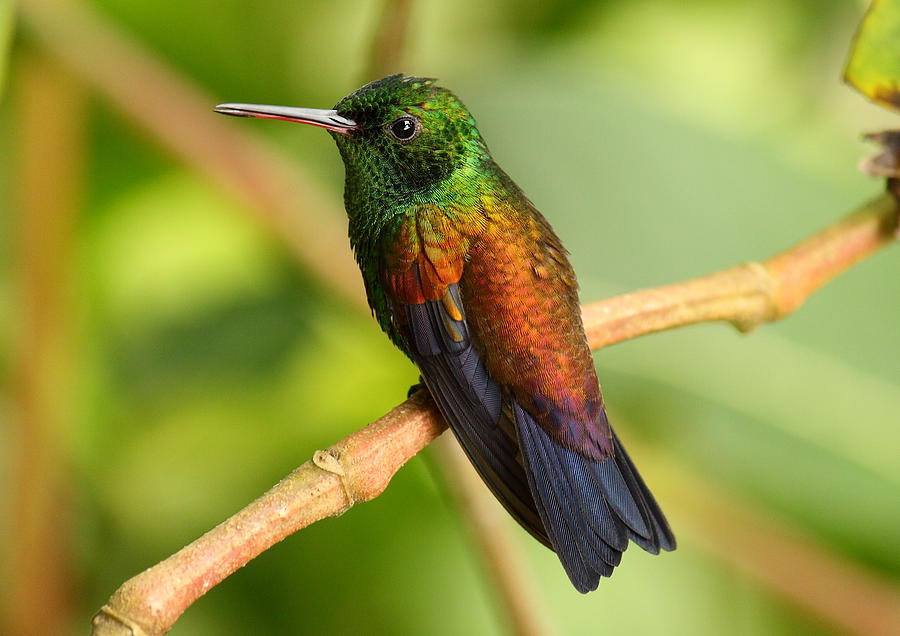

Juveniles resemble females but have some grayish brown on the throat and belly. Adult females are similar though their upperparts are a less intense bronze-green and they have some whitish on the chin and upper throat. They have dark golden-green underparts with reddish brown undertail coverts. tobaci have bronze-green upperparts with purple-red uppertail coverts. Both sexes of all subspecies have a straight, medium length, blackish bill with a pinkish base to the mandible. The copper-rumped hummingbird is 9 to 11 cm (3.5 to 4.3 in) long.

These seven subspecies of copper-rumped hummingbird are recognised by world-wide taxonomic systems: The specific epithet tobaci is from the island of Tobago, the type locality. The epithet was coined in 1846 by Adolphe Delattre and Jules Bourcier to honor the French physician and ornithologist Antoine Constant Saucerotte. The genus name is from the specific epithet saucerrottei for the steely-vented hummingbird, the type species. The genus Saucerottia had been introduced in 1850 by the French naturalist Charles Lucien Bonaparte. However, BirdLife International's Handbook of the Birds of the World (HBW) retains it in Amazilia. In the revised classification to create monophyletic genera, the copper-rumped hummingbird was moved by most taxonomic systems to the resurrected genus Saucerottia. A molecular phylogenetic study published in 2014 found that the genus Amazilia was polyphyletic. The copper-rumped hummingbird was formerly placed in the genus Amazilia. Gmelin based his description on the "Tobago Humming-Bird" that had been described in 1782 by the English ornithologist John Latham in his A General Synopsis of Birds. He placed it with all the other hummingbirds in the genus Trochilus and coined the binomial name Trochilus tobaci.

The copper-rumped hummingbird was formally described in 1788 by the German naturalist Johann Friedrich Gmelin in his revised and expanded edition of Carl Linnaeus's Systema Naturae. It is found in Tobago, Trinidad, Venezuela, and possibly Grenada. The call of this species is a chip, and the song is a high-pitched tyee-tyee-tyoo.The copper-rumped hummingbird ( Saucerottia tobaci) is a species of hummingbird in the "emeralds", tribe Trochilini of subfamily Trochilinae. Copper-rumped Hummingbirds perch conspicuously and defend their territories aggressively against other hummingbirds, bees, and larger bird species this is especially during mating season, which is early in the year. The food of this hummingbird is nectar, taken from a wide variety of flowers, and some small insects. There are several other subspecies in Venezuela differing mainly size and in the colour of the rump and back. The latter race has occurred as a vagrant to Grenada. erythronota, is smaller and has more bronzing on the upperparts than the nominate A. The subspecies which breeds in Trindad, A. The head and underparts are bright green, the thighs are white and the tail and legs are black. The adult has copper-green upperparts, becoming copper-bronze on the rump. The bill is fairly long, straight and mostly black with some pink on the lower mandible. The Copper-rumped Hummingbird is 8.6 cm long and weighs 4.7 g. It is the predominant species of hummingbird in Trinidad and Tobago. Incubation takes 16–17 days, and fledging another 19-23, and there may be up to three broods in a season. The female Copper-rumped Hummingbird lays its eggs in a tiny cup nest on a low branch, or sometimes wires or clotheslines. This hummingbird inhabits open country, gardens and cultivation. It is a seasonal migrant in parts of Venezuela. The Copper-rumped Hummingbird ( Amazilia tobaci) sometimes placed in the genus Saucerottia, is a small bird that breeds in Venezuela, Trinidad and Tobago, and has occurred as a vagrant on Grenada.


 0 kommentar(er)
0 kommentar(er)
